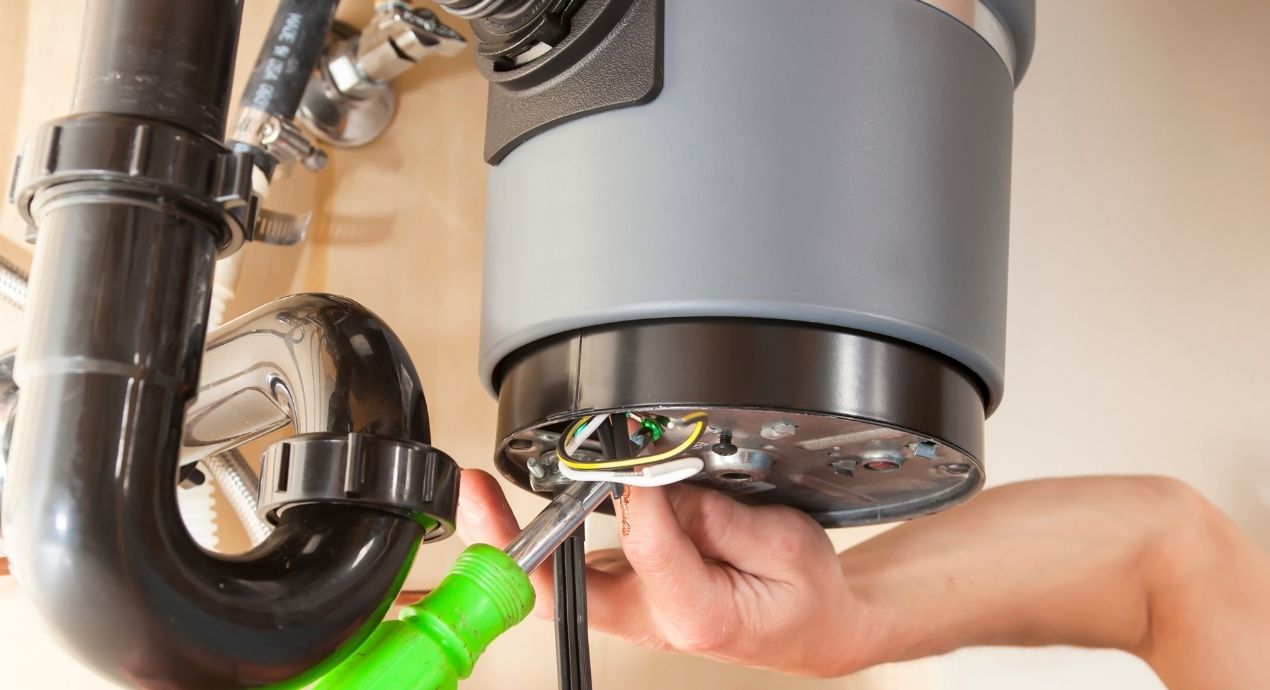
Contemplating coverage?
Subscribe to receive our emails & get
$200 off!
Have questions?
Call us: (833) 544-8273


Written By Erin Easley
Food disposals and garbage disposals are handy machines because they usually reduce the likelihood that your kitchen sink will clog up from leftover food scraps. Every now and then, however, exasperated homeowners may discover a clog even in a sink fitted with a garbage disposal. This could be due to an unusually large amount of debris, a faulty disposal, or some other problem.
Fortunately, troubleshooting to unclog garbage disposal mechanisms is usually quite straightforward. There are a few solutions homeowners can try on their own before calling a professional technician. In this article, we’ll help you understand how to unclog a food disposal or garbage disposal.
Before attempting to unclog garbage disposal, it’s crucial to understand what causes these blockages. Often, the culprits include large food particles, fibrous materials, or non-food items accidentally dropped into the disposal. Recognizing the cause of the clog is the first step in addressing the problem efficiently.
In most cases, it’s easy to fix clogged garbage disposal or food disposal mechanisms. Let’s take it step by step.
Without exception, your first step when troubleshooting any problem with your garbage disposal is to make sure it’s completely disconnected from its power source. Unplugging garbage disposal mechanisms is a good idea when power cords are within reach. If your disposal is directly connected to in-wall electrical wiring, cut power to the circuit at your circuit breaker or fuse box. This is a simple, straightforward precaution to minimize your risk of personal injury or damage to your appliance.
The next step is to inspect the inside of your drain and disposal for any visible obstruction. Do not insert your hand or fingers into the drain at any time. Even if your device is totally disconnected from a power source, this is a terrible idea. Use a flashlight and your eyes to determine the source of the clog. If you spot an object in there, you can use a tool of some kind to retrieve it. Long-handled pliers, tongs, or even a pair of chopsticks can work. Just ensure your hand is always above the drain threshold.
If you were able to retrieve an item, reconnect your disposal to its power source and test it. If you didn’t notice an object, or if the clog wasn’t resolved after removing the object, read on for more options.
If you had reconnected your garbage disposal to its power source, then disconnect it once again. If a buildup of food scraps is the source of your clog, you may be able to dissolve it with some common household ingredients.
One option is boiling water. Boil a few cups of water and pour it directly down the drain. You may have to repeat this step a couple of times. This simple strategy can often get rid of small clogs.
For more stubborn clogs, the dissolving action of baking soda and vinegar is a better bet. Pour about half a cup of baking soda down the drain and into the disposal. Follow with a cup or so of white vinegar or apple cider vinegar. You’ll immediately notice the chemical reaction as the mixture foams and bubbles. Allow this to sit for at least half an hour. Once that time has elapsed, flush with hot water.
If you’re still having trouble, move on to the next step. Avoid using chemical drain cleaners. Those industrial cleaners can actually damage your plumbing or even the garbage disposal itself.
A garbage disposal plunger is one effective method to unclog a garbage disposal. This tool is designed specifically for use with garbage disposals and can help dislodge clogs that are not too far down the drain.
If using a garbage disposal plunger does not resolve the issue, there are other methods to consider:
This natural cleaning solution can help dissolve clogs. Pour half a cup of baking soda into the disposal, followed by a cup of vinegar. Allow the mixture to fizz and work for a few minutes, then flush with hot water.
Some disposals come with a hex key that fits in a hole at the bottom of the unit. Using this key, you can manually turn the blades to dislodge clogs.
If all else fails, it may be necessary to call a professional plumber. They have the tools and expertise to fix a clogged garbage disposal safely and effectively.
May garbage disposal clogs are easily resolved, but the reality is that some clogs require the work of a professional. Some clogs may require labor that a homeowner is unable or unwilling to do. Sometimes, there could be something wrong with the disposal itself.
A home warranty with garbage disposal coverage is one way to protect yourself from a high garbage disposal replacement cost. You can also save on maintenance and repair costs for other home appliances and systems too. You can be sure that Liberty Home Guard has a plan for you. Use our website for a free quote or call (866)-526-1752.
Stay Ahead of Potential
Home Mishaps!
Subscribe to our Liberty Home Guard Newsletter and gain access to exclusive content that ensures your peace of mind.